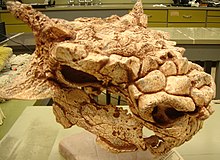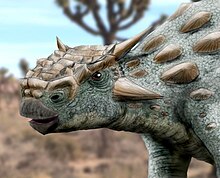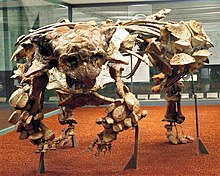Minotaurasaurus
| Minotaurasaurus Temporal range: Late Cretaceous,
| |
|---|---|

| |
| Skull of Minotaurasaurus | |
| Scientific classification | |
| Kingdom: | Animalia |
| Phylum: | Chordata |
| Clade: | Dinosauria |
| Order: | †Ornithischia |
| Clade: | †Thyreophora |
| Suborder: | †Ankylosauria |
| Family: | †Ankylosauridae |
| Subfamily: | †Ankylosaurinae |
| Genus: | †Minotaurasaurus Miles & Miles, 2009 |
| Species: | †M. ramachandrani
|
| Binomial name | |
| †Minotaurasaurus ramachandrani Miles & Miles, 2009
| |
Minotaurasaurus (meaning “Minos'-bull reptile”) is a monospecific genus of ankylosaurid dinosaur that lived in Mongolia during the Late Cretaceous (Campanian, ~75-71 Ma) in what is now the Djadochta Formation.
Discovery and Naming[]

The holotype, INBR21004, was obtained by the private fossil collector Vilayanur S. Ramachandran for $10,000 from the fossil poacher Hollis Butts at the Tucson Gem, Mineral and Fossil Showcase in Arizona.[1] The specimen consists of a skull with complete lower jaws and predentary.[2] The provenance of the holotype became controversial amongst palaeontologists after the paper describing the specimen was published as it was illegally taken from the Gobi Desert.[1] V. S. Ramachandran says that he would be happy to repatriate the fossil to the appropriate nation, if someone shows him "evidence it was exported without permit".[1] The specimen itself is currently housed at the Victor Valley Museum in Apple Valley, California.[2][1]
The generic name Minotaurasaurus is derived from the mythical creature the Minotaur, that had a body of a man and the head of a bull.[2] This is in reference to the bull-like appearance of the holotype skull.[2] The specific name, ramachandrani, honours V. S. Ramachandran as they made sure that the holotype was described and made available to science.[2]
In 2013, a second specimen, MAE 98 179, consisting of a skull, axis, and first cervical half-ring was assigned to Minotaurasaurus from the Djadochta Formation at Ukhaa Tolgod locality, establishing the provenance of this taxon.[3][4]
Description[]
The holotype skull measures 30 centimetres (7.9 inches) long and represents an individual with a total length of 4.2 metres (13.8 feet), although it may have reached larger sizes as the holotype specimen probably represents an immature individual based on the unfused osteoderms on the skull.[2]

Although no postcranial material belonging to Minotaurasaurus has been recovered, besides a cervical half-ring, it would have had a tail club that may have been used for intraspecific or interspecific combat, numerous osteoderms running across its body, a barrel-like body, and short, robust limbs based on close relatives. Its skull is ornamented with pyramid-shaped osteoderms and is roughly bi-symmetrically arranged on the skull.[2] The squamosal horns form the widest point of the skull roof which are more gracile and tapering than any other ankylosaurid.[2] The skull also shows a blend of characters seen in other ankylosaurids like the presence of a quadratojugal horn. [2] The braincase has features that are more primitive than those of other ankylosaurids from the Gobi Desert. [2] The bilateral symmetry and lack of deformation of both the left and right jugal horns show that the jugal horns thrust more laterally than ventrally, a feature not seen in other ankylosaurs such as Tarchia and Saichania.[2] The teeth are leaf-shaped and bear vertical striations dividing the crown surface into eight cusps.[2] Some of the teeth show apical wear, which is unusual as ankylosaurids typically have wear on the crown face. [2]
Classification[]
A 2014 study by Victoria Arbour, Philip Currie and Demchig Badamgarav suggested that Minotaurasaurus was probably a junior synonym of Tarchia, and the holotype was from the Barun Goyot Formation.[5] However, a 2016 paper Paul Penkalski and Tatiana Tumanova redescribed the cranial anatomy of Tarchia and concluded that Minotaurasaurus was a valid taxon.[4]

A limited phylogenetic analysis conducted in the 2016 redescription of Tarchia, focusing on the interrelationships between Tarchia, Saichania, and Minotaurasaurus, is reproduced below.[4]
| ||||||||||||||||||||||||||||
Paleoenvironment[]

The fossil remains of Minotaurasaurus were likely recovered from sediments of the Djadochta Formation, which dates to the Campanian stage of the Late Cretaceous, 75 to 71 million years ago. Minotaurasaurus would have been contemporary with various species of terrestrial turtles, crocodilians, lizards, mammals and dinosaurs, such as the alvarezsaurid Shuvuuia, the ceratopsians Protoceratops and Udanoceratops, the dromaeosaurids Tsaagan and Velociraptor, the halszkaraptorines Halszkaraptor and Mahakala, the oviraptorosaurs Citipati and Oviraptor, and the ankylosaurid Pinacosaurus. Based on strata, rock facies, sedimentation and coeval units, the Djadochta Formation represents an arid environment consisting of sand dunes and short-lived water bodies with a warm semiarid climate.
See also[]
References[]
- ^ a b c d naturenews, February 2, 2009
- ^ a b c d e f g h i j k l m Miles, Clifford A.; Miles, Clark J. (2009). "Skull of Minotaurasaurus ramachandrani, a new Cretaceous ankylosaur from the Gobi Desert". Current Science. 96 (1): 65–70.
- ^ Alicea, Justy; Loewen, Mark (2013). "New Minotaurasaurus material from the Djodokta Formation establishes new taxonomic and stratigraphic criteria for the taxon" (PDF). Journal of Vertebrate Paleontology. 33: 76.
- ^ a b c Penkalski, P.; Tumanova, T. (2017). "The cranial morphology and taxonomic status of Tarchia (Dinosauria: Ankylosauridae) from the Upper Cretaceous of Mongolia". Cretaceous Research. 70: 117–12. doi:10.1016/j.cretres.2016.10.004.
- ^ Arbour, Victoria M.; Currie, Philip J.; Badamgarav, Demchig (2014). "The ankylosaurid dinosaurs of the Upper Cretaceous Baruungoyot and Nemegt formations of Mongolia". Zoological Journal of the Linnean Society. 172 (3): 631–652. doi:10.1111/zoj.12185.
- Ankylosaurids
- Late Cretaceous dinosaurs of Asia
- Gobi Desert
- Fossil taxa described in 2009
- Ornithischian genera
- Ankylosaurian stubs

